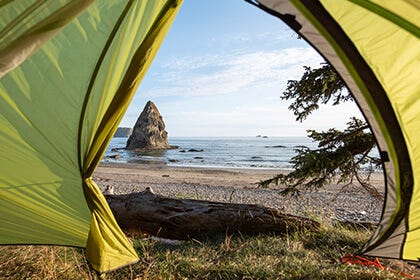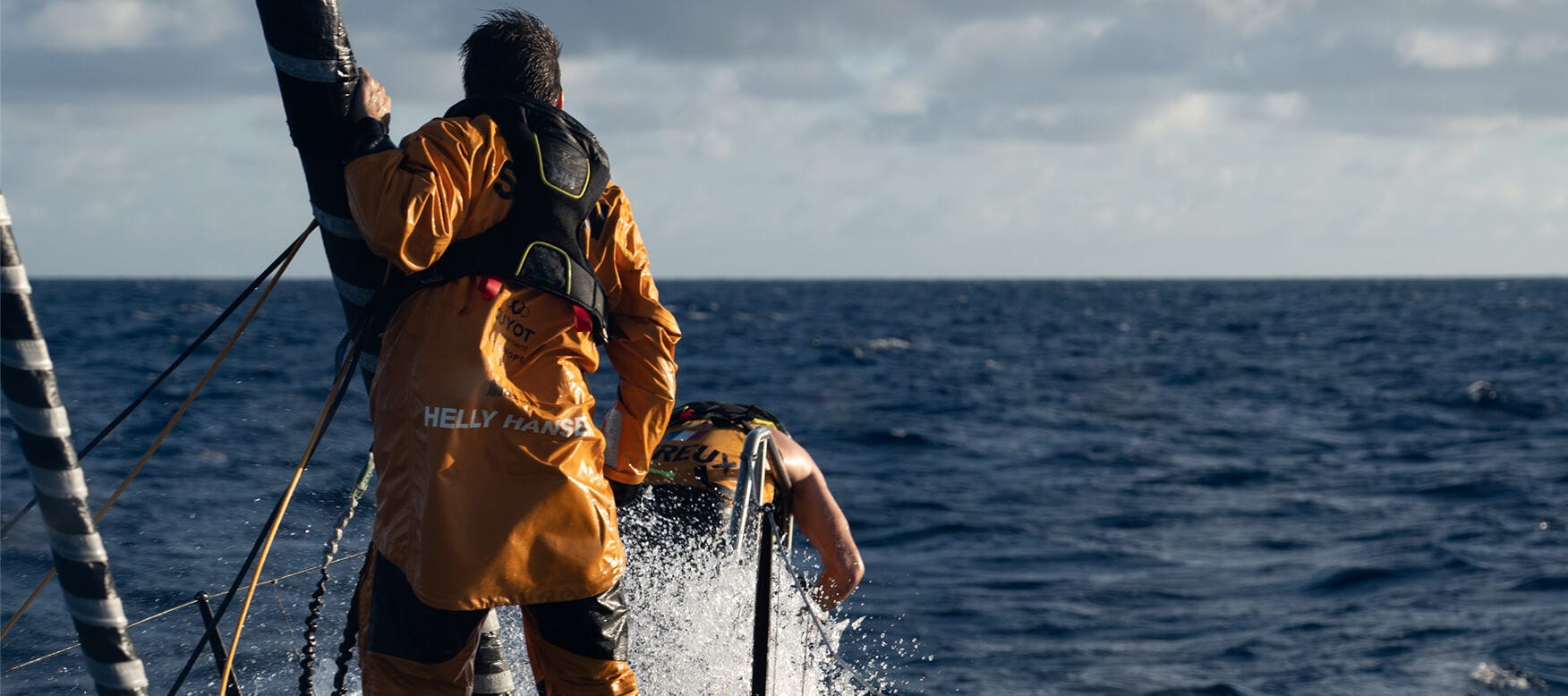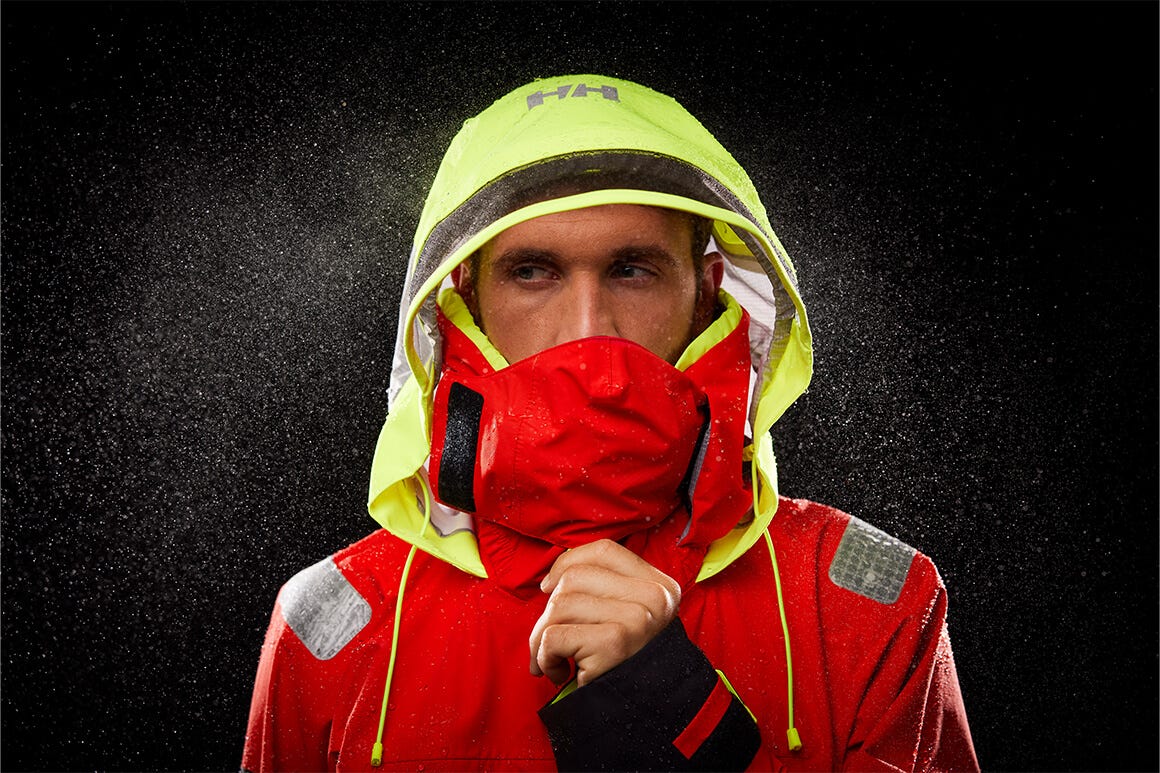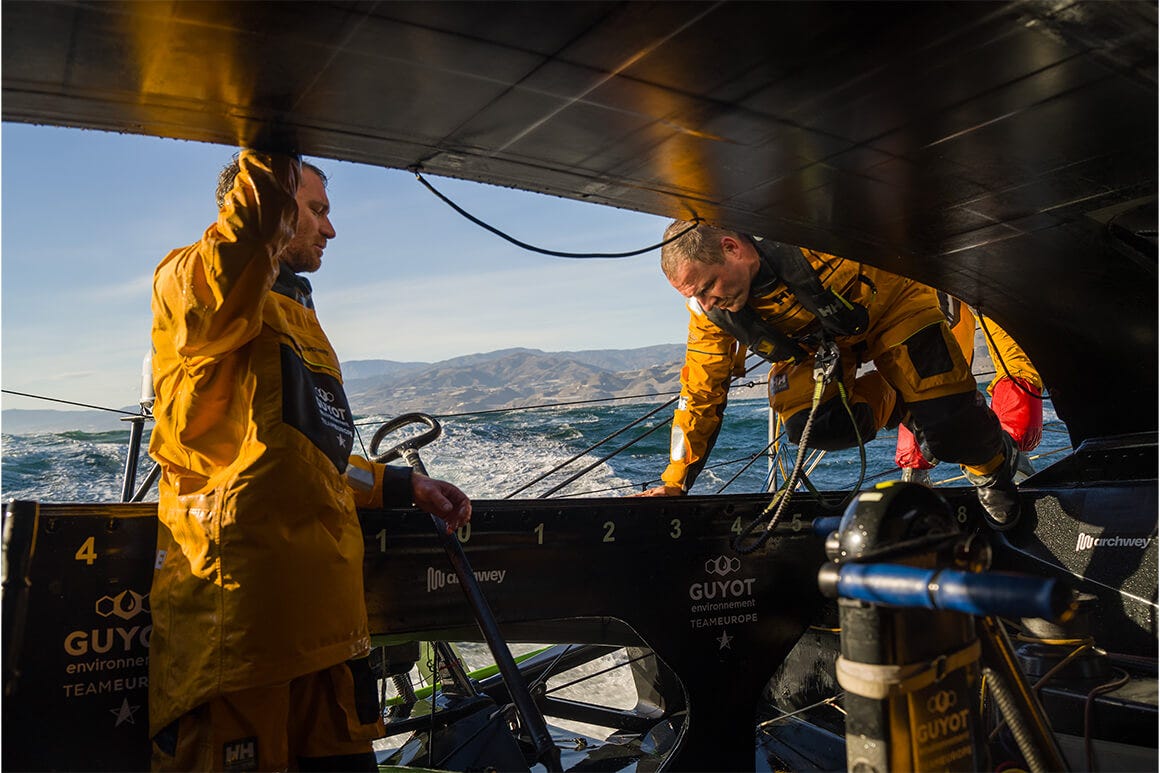
Local Storage seems to be disabled in your browser.
For the best experience on our site, be sure to turn on Local Storage in your browser.
Local Storage seems to be disabled in your browser.
For the best experience on our site, be sure to turn on Local Storage in your browser.

HELLY TECH® and The Ocean Race
June 23, 2023
8 min read
How do you test the waterproof and breathable performance of a jacket? You sail it around the world. Although lab tests are a great start, the true test is how it performs over time and in the harshest conditions.
HELLY TECH®, our waterproof and breathable technology, was first developed and tested for the Berge Viking team in the Whitbread Around the World Race. This testing ground led to its introduction in 1984, but the technology has evolved exponentially since then. Our latest Ægir offshore sailing collection features our most lightweight and breathable HELLY TECH® to date. Learn about Ægir Race and what it means to be trusted by professionals.
Since becoming Official Clothing Supplier for The Ocean Race in 2019, we have outfitted the race staff, elite ocean racers as well as the fans. Sailors taking part in the The Ocean Race face extreme conditions, including harsh weather and towering waves, temperatures from -15 to +40 degrees Celsius, and taking only one change of clothes with them on board. Therefore, the Ægir gear had to be windproof and deliver high breathability, water resistance and water repellency.
Building on our existing Ægir collection, we wanted to add a jacket that accomplished these three goals:
1. More waterproof
2. More lightweight
3. More responsible materials
On paper, it sounds simple. In practice (and a worldwide pandemic, no less) it took over three years to bring the Ægir Race Jacket 2.0 to life.
Ask any ocean racer the most important quality of sailing gear and they will say waterproof. But how could we make the jacket even more so? The clue lies in the membrane, seams, fabric, and a lot of testing (both in-house and in the field).
Waterproof/breathable membranes are normally either hydrophilic (water-loving) or microporous (thousands of tiny pores smaller than a water molecule to prevent water from entering). In the case of Ægir, we combined both into a hybrid version. Also known as a bi-component, this is made up of two layers:
Both layers work together to keep water out, heat in, and enable moisture to escape.
We started by testing and comparing three different types of fabrics, then narrowed it down to one.
HELLY TECH® is a tough weatherproof outer layer, specially designed for the harshest conditions. It is a combination of a DWR-treated outer fabric, a highly waterproof and breathable membrane (mentioned above), and often a highly breathable inner fabric, mesh or lining.
With our history of protecting sailors from the harsh conditions, The development of our most advanced HELLY TECH® fabrics have been subject to heavy testing both in the lab and with sailors. From the early 80s, HELLY TECH® was manufactured in Moss, Norway. Today, we still develop and test based out of our HQ in Norway, but work with a global pool of advanced suppliers today.
Since The Ocean Race campaign in 2008 and first bicomponent laminate, only 4 generations of fabric have made it through all the tests to become part of our Ægir series of ocean racing gear. After testing multiple trials and options the fabric for the Ægir Race 2.0 is again made with Toray, our partners in Japan. They also made the HELLY TECH® used in the previous generation and are famous for making the carbon fibre fabric used to manufacture the Boeing dreamliner airplanes.
Seams are usually the weakest part of clothing and wear out easily. They can also make the fabric leak and limit movement. So, we made some changes to reduce this risk. We used fewer seams and removed them from areas like the shoulders that are most exposed. The seams we kept are fully sealed and bonded with thermoplastic tape, which makes the gear more water resistant.

Ocean racing gear is also about marginal gains. Whether it’s the materials used to build the boat, the supplies and gear taken on board, weight matters. But so does performance. When exposed to such foul conditions, however, it is easier said than done. So, what did we do?
The first area we looked at to reduce weight was the hood. Now packable and lighter with a transparent PVC visor and UPF filter, sailors can focus on the task in hand without worrying about visibility and the reflection of sun rays from the water.
Professional sailor Thomas Coville provided valuable feedback regarding our previous Ægir gear, suggesting that we could make the reinforcements lighter. We listened to his feedback and made improvements by using lighter reinforcements on impact areas like the elbows and knees.

As The Ocean Race aims to cut greenhouse gas emissions by up to 75% compared to the previous edition, we continue our drive to bring more responsible materials to the collection. In The Ocean Race Merch collection, we incorporated Ocean Bound recycled materials.
We've paid a lot of attention to PFAS chemistry over the years. As a company we are phasing out PFAS from our products and are in close cooperation with research institutes, chemical suppliers of PFAS-free DWR treatments. Long ago we used C8 PFAS, which were considered the most effective due to their low surface tension, but emitted harmful by-products.
In our transition period to PFAS-free for this offshore collection, we discovered that the early generations performed well in initial tests, but the treatments were not durable enough for washing or extended wear, so we made a stop gap at C6 PFAS. When the crew only has one set of clothing to take them around the world, we could not sacrifice quality. That was the case until now.
Thanks to the industry’s dedication to phasing out PFAS and heavy R&D work, we have now completed the transition to a PFAS-free treatment in our Ægir collection that makes no compromise on performance.
It is one thing to test a square of fabric on its own, but it is another to test it when formed into a garment, and an entirely different matter to test it in real life scenarios (the open ocean). Without one of these testing phases, the rest would be void. It was also important for us to remain objective. Although some tests were conducted in-house, we outsourced the rest to external labs and the professionals themselves.
We let the sample of fabric tumble for several hours in a shock box — a machine that we developed in-house especially for this collection. The shock box works as a pre-treatment to see how well the fabric performs in terms of impact, abrasion, salt contamination, DWR, delamination and waterproof qualities.
To mirror the elements that the sailors would face on their treacherous ocean journey, we added a saltwater concentration to the shock box. Salt is a huge challenge, particularly when it comes to sailing because it can quickly clog the membrane’s pores, affecting multiple aspects of performance (including waterproof and breathable qualities).
Our 3rd party testing agreement covered all aspects of the fabric’s performance, including waterproofness, durability, surface repellency (spray testing), tensile and tear strength. These tests determine if the fabric will perform as expected when formed into a garment. Only when the fabric meets these requirements, do we move onto field testing.
Our supplier tests the tape to meet our standards. We look at the tape's performance and appearance to determine if it's suitable for use. To test the tape's performance, we use a hydrostatic test as new and after five washes. The tape must withstand 10 PSI for two minutes as new and 7 PSI for two minutes after washing. For appearance, we check that the tape doesn't show any press marks, puckering, or edge lifting (when the tape separates from the fabric). The result is either pass or fail. The tape must meet all our requirements and have a satisfactory appearance to pass. Once the tape passes, we can approve it for use on our garments.
Water-repellent gear is crucial for offshore sailing due to the wet and challenging conditions. To ensure our gear meets the required standards, we conduct spray testing to ISO 4920. This test determines how well the fabric resists getting wet from water on its surface. A fabric sample is placed over a supporting stand, and water is continuously showered onto it from a funnel containing 250ml of water. The fabric is then rated from 1 to 5, with 5 being the highest grade indicating no sticking or wetting on the fabric's surface. When tested as new, our gear should rate the highest, then a minimum of rating 4 after 5 washes.
We test the physical properties of our fabric to ensure it meets our standards for durability. This includes testing the membrane bonding strength (ISO 2411), tensile strength (ISO 1421), tear strength (13937-2), and abrasion (12947-2). Our testing results must meet strict internal requirements.
By this point, the updated design style was still in progress, but we were able to make samples with the selected fabric using a previous product. We developed the latest Ægir collection at the height of COVID-19 when travel was not possible. But even a pandemic wouldn’t stop our R&D Manager, Dr. Issam Yousef from taking on a challenge. With a Ph.D. in woven fabrics mechanics and technology, he knows a thing or two about textiles. Issam took the product into a shower and exposed it to a high water pressure for 15 minutes whilst rubbing it against the wall. The product showed little sign of degradation and the product was ready for the next test.
All that remained was field testing, the biggest test of them all. We sent the samples to professional offshore sailors, Pip Hare and Thomas Coville, to test in real life scenarios. Although our objective was to make Ægir more waterproof, other factors such as comfort and breathability also play a role. The cut and feel of a product can impact performance and the feedback from the professionals provided valuable insight into this.

There are multiple challenges involved in not only bringing a pinnacle collection like Ægir to life, but also updating it. The fast-changing nature of sailing boats demands continuous innovation and tweaks to offshore sailing gear. The timelines are forever tight, and the testing process must be completed far in advance. Even now, the SS24 Ægir collection is being tested by professional offshore sailors.
The Ocean Race is arguably the world's toughest team sailing event, where the best offshore teams battle it out across 32,000 miles on the most treacherous oceans. The marathon of the seas is an exceptional test of sailing prowess and human endurance, and the 14th edition of the race started in Alicante, Spain, on January 15th, 2023.
Hero banner credit: Gauthier Lebec / GUYOT environnement - Team Europe / The Ocean Race


June 11, 2024 3 min read
Sharon Birchfield, a seasoned guide with Mountain Madness, shares her insights on the true essence of mountain guiding.

June 06, 2024 2 min read
Professional endurance athlete Caroline Côté shares her insights on the mental and physical aspects of trail running.